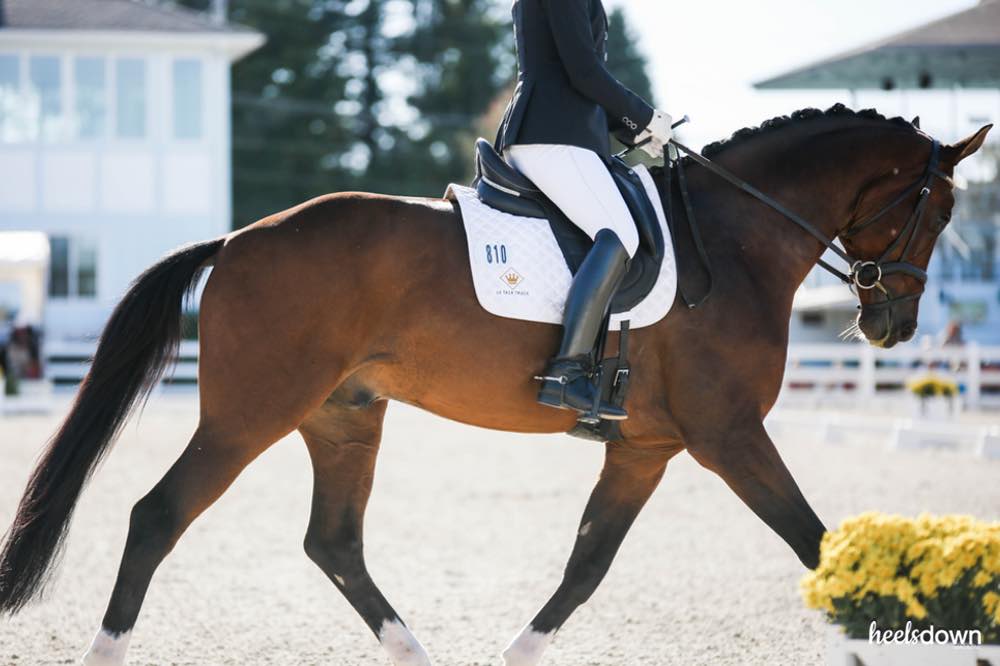Put Your Horse On the Bit Correctly: 'More of a Feeling Than a Picture'

To have a horse correctly on the bit, you need both ends of the horse. Some people are afraid of the contact, but without that you can’t complete the connection from the hind end.
This article first appeared in the March 2018 issue of Heels Down Magazine. For more stories worth your time, subscribe to the magazine in the app.
There is something to be said about the elegance and flawlessness of a horse that is moving properly on the bit and balanced in his gaits.
It is, after all, what all riders hope to achieve, no matter the discipline.
Eiren Crawford, a grand prix dressage rider and clinician, has spent the better part of her career riding horses from a variety of disciplines to find the “feel” that comes with establishing the perfect, balanced, on-the-bit ride.
“The most important thing is that the horse being on the bit is more of a feeling than a picture,” said Eiren, 41, who runs her own business, All Points Dressage. “To me, it’s about thoroughness, so the horse has to be using its whole body. The hind ends have to be involved and it’s all the way through to the bit and the feeling in your hand.”
This is no easy task. Take it from Eiren, who moved to Germany in 2008 to be a working student for Lars Petersen and later to work for Olympic Gold Medalist Ingrid Klimke, where she assisted in the development and training of both dressage and three-day event horses. Alongside Ingrid, Eiren developed a commitment to conditioning the whole equine athlete, using cavaletti and other cross-training techniques to bring out the best in her dressage horses.
But finding the right feel requires a lot of give and take, she says.
If the horse is in a good balance, he should be able to maintain that on his own. If not, then it’s not self carriage.
“To have a horse correctly on the bit, you need both ends of the horse. Some people are afraid of the contact, but without that you can’t complete the connection from the hind end,” Eiren explains. “The bit has to be part of the conversation with the horse. You have the hind legs active and energized, and your hand has to talk to the horse. If the hands don’t do enough, you’re not giving direction. But if they do too much, then you’re not listening to the feedback.”

If a horse is stiff or resistant, Eiren recommends lateral work to help encourage them to accept the contact. That includes exercises like leg yielding, which helps break up stiffness and resistance in the horse’s body.
“You can supple one side at a time and create a more pliable topline that will give you the contact,” she describes. “Classic instruction is support with the outside rein and then a suppling feeling on the inside rein. But watch that the inside rein is not ‘stopping’ rather than supporting.”
A horse is only truly on the bit if the rider can soften the contact and if he continues to stay there for a few strides without any direct contact from the rider, Eiren says. But she adds that no horse is going to stay truly connected for too long.
“I don’t have a problem if people put the horse up or down or left or right if they can soften and a horse is comfortable,” she admits. “If you put a horse’s neck in a position and it’s taking all of your strength to keep it together, then it’s not correct. That’s how I define self carriage. If the horse is in a good balance, he should be able to maintain that on his own. If not, then it’s not self carriage.”
The most important thing is that the horse being on the bit is more of a feeling than a picture.
Eiren says that finding that feeling of knowing when you’re riding a horse in true self carriage takes some training. A rider should feel a “bit of softness” in the horse’s back, but also a new strength with a swinging – not rigid – back.
“Contact is like holding hands with a toddler on either side of you. Toddlers are not super good at walking, but they kind of have an idea on how to stay up. If you hold them up so their feet don’t touch the ground, they’re never going to learn how to walk. But if you never soften and allow them to balance on their own, then they won’t learn,” Eiren says. “If you let go too much, they fall on their face. Walking with toddlers, you have to get from point A to point B. Even if they’re good at walking, they can still fall down. That’s how I ride my horses into the contact correctly.”


